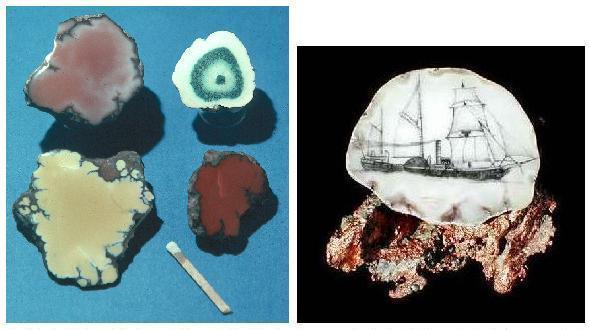( Fr- datolite; Ger- Datolith;
Nor- datolitt; Rus-![]() )
)
DATOLITE, CaBSiO4(OH).

A. Datolite polished slices (match gives scale) from Keweenaw Peninsula, Michigan. (© photo by D.L. Brittain)
B. Datolite from Keewenaw Peninsula, Michigan with U.S.S. Michigan “scrimshaw engraving” (width - 12.3 cm) atop a native copper easel, also from the peninsula. Engraver, Jim Billings - for a description of processes Billings uses, see Robinson (2000). (© photo courtesy of Jim Billings, www.swedesgifts.com)
DESCRIPTION: Gemrock variety that comprises porcelaneous fine-granular masses, widely referred to as nodules:OTHER NAMES:
USES: Usually as cabochons, less commonly as polished "flats" for relatively large pieces of jewelry such as pendants and brooches; also for decorative items such as the illustrated “scrimshaw engraving” (Figure B).
OCCURRENCES: The following are based on data from the Keweenaw Peninsula of the Upper Peninsula of Michigan, with much of the information and the quotations from Rosemeyer (2003): As nodules, ranging up to "more than 18 inches [~ 45 cm] across"; as cavity fillings in basaltic rocks; sporadically as the matrix material of brecciated basalts; as "chalky white pebbles and cobbles" in sporadic gravels within the area; [and] "In the late 1990s the area became popular with many mineral-collectors- turned-scuba-divers or vice versa, who worked the bottom of the lake for loose and in-siu datolites." Also, as might be expected, several nodules have been found in the mine dumps (see under next subheading).
NOTEWORTHY LOCALITY: Michigan "Copper country" -- see localities on the Keweenaw Peninsula and Isle Royale National Park of northwestern Michigan given by Rosemeyer (2003), who notes that "datolite nodules have been found at more than eighty mines and prospects in the Michigan copper district (excluding Isle Royale National Park), but only about forty have supplied specimen-grade datolite in both size and color. Three localities stand out as being "classic," based on the sheer number of nodules recovered and their sizes and diversity of colors and patterns. These are the Delaware mine, the Pewabic lode (Quincy, Mesnard, and Franklin mines), and the Caledonia mine."
REMARKS: Dense massive datolite used as a gemrock is quite unlike the more widespread typically transparent crystals of datolite. It is of at least passing interest, however, that the mineral name was based on the compact massive variety -- i.e., gemrock type, porcelaneous datolite. This name, which Dana (1892) notes as introduced in 1806 by Professor Jens Esmark of the famous Mining Academy at Kongsberg, is based on the Greek δατέισθαι (to divide), which alludes to the granular texture. The type locality, where both the compact massive variety and crystals occur is Arendal, Norway.SIMULANT:
Bakerite, Ca4B5Si3O15(OH)5
(i.e., the massive porcelaneous variety
found as nodules) - although the appearance of both
nodules and polished pieces roughly resemble datolite, I have never
seen any bakerite marketed as datolite; nonetheless, one should
be on the
lookout for such a substitution. - [inferior hardness (H.4½)]. (By the
way,
bakerite has also been used as a trade name -- i.e., "Bakerite [,] oven-tested" --
for porcelain chinaware items such as cake plates, pie "tins" and bean
pots.)
Howlite, Ca2SiB5O9(OH)9
(i.e., the massive porcelaneous
variety found as nodules) - although the appearance of both
nodules and polished pieces resemble datolite, and it is know that it
is rather easily dyed and consequently could be dyed to more or less
match at least some of the diverse colors of datolite, I have not seen
any
howlite marketed as datolite; nonetheless, one should be on the
lookout for such substitution. - [inferior hardness of howlite (H.3½)].
REFERENCE: MacFall, 1983; Rosemeyer, 2003, 2005 & 2009.
R. V. Dietrich © 2015
Last
update: 8 March 2009
web page created by Emmett Mason